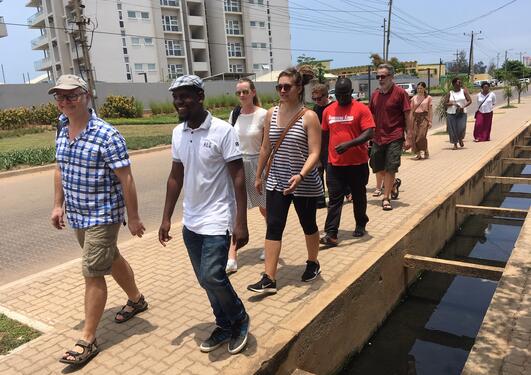An urban research project takes on the SDGs
How do enclaves that arise as cities within a city, impact on urban planning and the creation of liveable and sustainable cities for all citizens? This is one of the central themes in the research project Urban Enclaving Futures.

Main content
The interdisciplinary research project Urban Enclaving Futures (UEF) looks at the development of enclaves in cities beyond classic economic understandings of urban development. The researchers study social, cultural, spatial and other dimensions to fully understand the impact of enclaving in modern cityscapes.
Making a case for urban sustainability
A major component of the UEF project is taking onboard issues of sustainability by looking at how enclaving impacts on creating sustainable development, comparing the African cities of Accra, Johannesburg and Maputo.
“What you find in the rise of the urban enclaves is the so-called self-sustaining city,” says Professor Bjørn Enge Bertelsen from the Department of Social Anthropology at the University of Bergen (UiB), before asking, “but how do these enclaves, often behind walls, engage with the city outside of the enclave and how does this impact on the overall sustainability of both the local community and global goals to create a sustainable world?”
In the workshop, the researchers discussed sustainable city planning as a central part of the project. These enclaves are extremely car-based and use more energy than the cities as a whole. Current development of urban enclaves does not promote sustainable city planning in terms of transportation and use of public transport.
Urban enclaving and the SDGs
UiB has taken a national leadership role in the university sector in engaging with the Sustainable Development Goals (SDGs). As Norway's premier SDG-oriented university, UiB has also been declared SDG 14: Life Below Water Hub for United Nations Academic Impact (UNAI) and is part of the International Association of Universities' (IAU) SDG Cluster, also on SDG14.
UEF touches on many of the 17 SDGs, but Bertelsen wants to move beyond traditional Western notions of Africa as a poverty-stricken continent, and instead prefers to focus on the rapid growth and its consequences – and possibilities – for Africa.
This is why UEF has singled out two SDGs of particular interest for the project and its researchers, yet at the same time in tune with the hopes and aspirations of Africa's young and growing population.
“SDG 11 on urban planning is one of the sustainability issues of interest for the project as well as SDG 8 on decent and meaningful work,” says Bjørn Enge Bertelsen elaborating on this, “enclaving in its multiple forms and representations and manifestations kills the notion of urban planning. The rise of enclaving is the final blow to the modern fiction of urban planning. This is why we need to think about what city planning means in the age of enclaving and how this impacts on sustainability issues.”
Giving science advice on urban development
As part of its SDG-orientation the project aims to contribute with scientific advice to bring critical dimensions on global sustainable development to decision-makers internationally and nationally.
“The world is becoming urban but what that means is also changing; we are no longer talking about cities in the conventional sense and enclaving is a prime symptom of this transformation. For this project it is therefore important to make our research and findings available to stakeholders and policymakers—aiming also to enter into dialogue with these and offering science advice about, for instance, the new forms of inequalities as well as possibilities that arise,” says Bertelsen.
- The project uses the Twitter hashtag #UrbanEnclaving
There will be further Urban Enclaving Futures workshops in Accra in January 2020 and in Johannesburg in January 2021, where also the SDG-orientation in the project will be elaborated upon.

